Gazania linearis
Gazania linearis (Thunb.) Druce
Family: Asteraceae
Common names: narrow-leaved treasure flower, tufted gazania, bensli (Eng.) botterblom, gansblom, gousblom (Afr.); ubendle, uhlubi (isiXhosa); isiphepane, ububendle, ubuendle (isiZulu)
Introduction
Gazania linearis, commonly known as the treasure flower, is a vibrant perennial that brings a splash of colour to gardens with its striking bright yellow daisy-like flowers. This drought-resistant plant thrives in sunny, well-drained areas, making it an excellent choice for low-maintenance flowerbeds like rockeries.
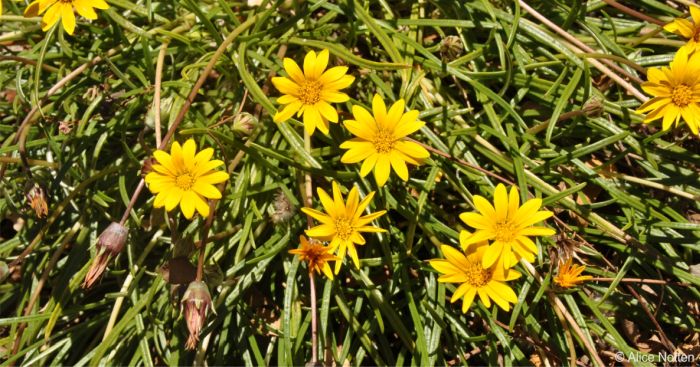
Description
Description
Gazania linearis is a small, clump forming perennial herb, growing 100–300 mm tall. The leaves form a rosette at the base, measuring 80–300 mm long and 1–10 mm wide, sometimes up to 25 mm wide. They are long, narrow and lance-shaped, occasionally oval, either whole, partly divided, or fully divided with 1–6 deep cuts. The upper surface is smooth or slightly rough, while the underside is covered in soft white hairs, except along the midvein. Flower heads grow on stalks that are 100–350 mm long, usually shorter than the leaves, with a few narrow bracts. The flower head is bell-shaped, with involucral scales arranged in 2–3 rows. The outer scales are narrow with fine hairs along the edges, while the inner scales are sharply pointed and smooth-edged, measuring 8–18 mm long and 2 mm wide. The petals are yellow to orange, sometimes with dark spots at the base. Flowers bloom mainly in spring and early summer, but may bloom sporadically throughout the year, depending on rainfall.
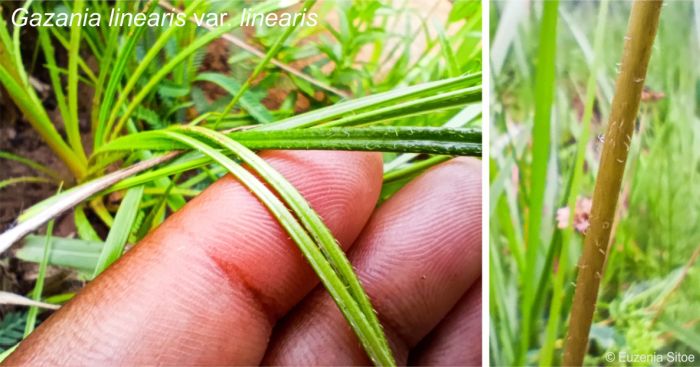
Gazania linearis has two recognized variants: var. linearis and var. ovalis, which differs from the typical variety in having oval leaves and only occurs in the Eastern Cape.
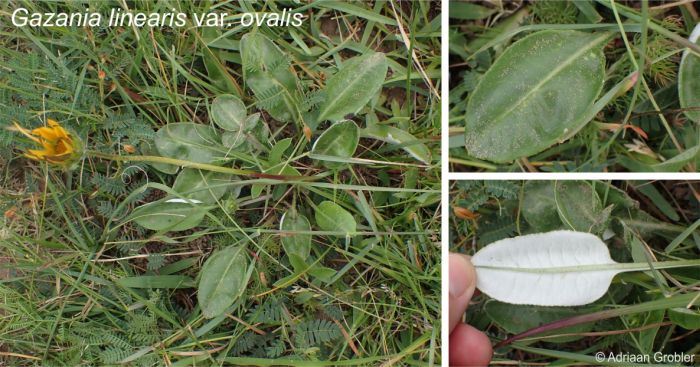
Conservation Status
Status
The conservation status for both varieties of Gazania linearis is Least Concern (LC) according to Red List of South African Plants. This means that the plant population is stable in the wild and it is currently at low risk of extinction.
Distribution and habitat
Distribution description
Gazania linearis grows in disturbed grasslands and various vegetation types, including Sub-Escarpment Grassland, Albany Thicket, Eastern Fynbos-Renosterveld, Sub-Escarpment Savanna, and the Indian Ocean Coastal Belt. It is widespread, occuring in the eastern parts of the Western Cape, through the Eastern Cape and extending to KwaZulu-Natal. This species typically grows in sandy soils in open grasslands and disturbed areas such as roadsides and pastures. It thrives in regions that receive rainfall in summer and prefers dry conditions with temperatures that can range from mild to warm. Gazania linearis is frost-tolerant and can flourish in areas with low to moderate rainfall, making it suitable for cultivation in well-drained soils that receive full sunlight. It has been introduced and become naturalized in other countries including southern and eastern Australia, New Zealand, and parts of the USA.
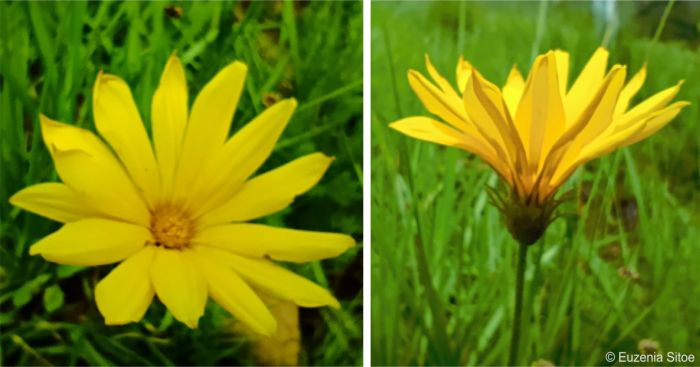
Derivation of name and historical aspects
History
The genus Gazania was named after Theodore of Gaza, a 15th-century scholar known for translating botanical texts from Greek into Latin. The species name linearis means ‘linear’, which describes the plant's slender leaves.
Ecology
Ecology
Gazania linearis beautiful, bright yellow flowers are particularly attractive to bees and butterflies, which are essential for pollination. The seeds are covered in long hairs and are easily dispersed by wind and germinate readily after rain. The plants can survive adverse conditions like frost and drought.
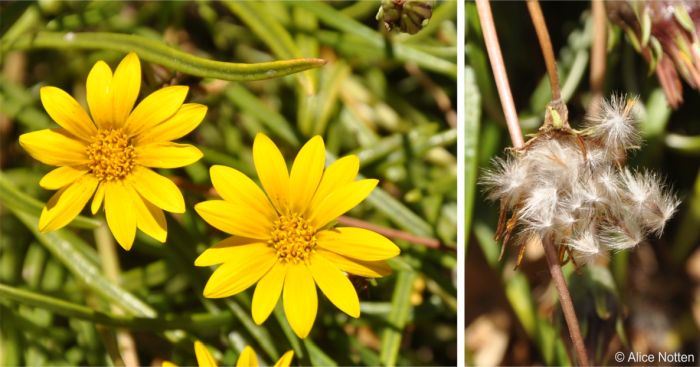
Gazania linearis and Gazania rigens have escaped from gardens and become invasive weeds in Australia where they are causing a big problem. They have spread widely and can now be found along roadsides, in grasslands, on coastal sand dunes, and in both natural and managed areas. These plants spread through seeds and underground parts, which are moved around by wind, water, machinery, and roadside mowing. This allows them to take over native plant areas, pastures, and farmland.
Uses
Use
The genus Gazania is a member of the Asteraceae, and it includes about 25 herbaceous species that are native to South Africa. These plants are known for their bright yellow or orange, daisy-like flowers, and are used for both aesthetics and traditional medicine.
Gazania linearis has many uses in the garden beyond adding bright colour to flowerbeds. It works well as a ground cover, helping to keep moisture in the soil and reduce erosion, while its lush green strappy leaves provide texture and foliage colour in sunny flowerbeds. It’s also a great choice for rock gardens, as it is a waterwise plant that can handle dry conditions, and it also does well as a container plant or in hanging baskets.
The whole plant is used in traditional medicine, and the roots are an ingredient in medicines given to sickly babies in the Eastern Cape.
In the past in KwaZulu-Natal, the felty white mat of hairs on the underside of the leaves was scraped off, threaded with beads and used to make the fringe for the skirts worn by young girls.
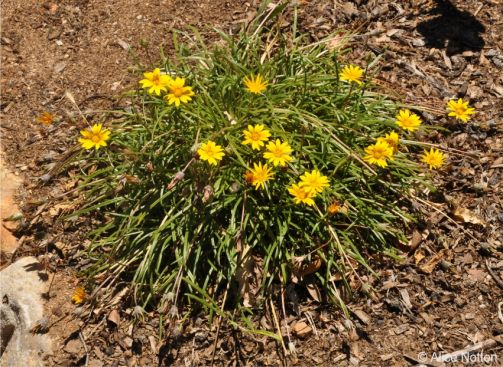
Growing Gazania linearis
Grow
Gazania linearis is easy to grow and can be propagated by seeds, cuttings, or division.
Collect seeds as soon as they are mature and sow them in a well-drained soil mix in early or late spring. Keep the soil moist until the seeds start to germinate. Once the seedlings are 3 to 4 weeks old, transplant them into a well-drained medium. Allow them to harden off for 2 to 3 weeks before planting them in the garden.
Choose well-established clumps, water them to soften the soil, making it easier to dig them out without damaging the roots. Gently separate the individual plants from the clump. Trim any long roots slightly, then replant in well-drained soil. Adding organic fertilizer helps reduce transplant shock and supports healthy growth. The best time for dividing plants is early spring.
Take cuttings in spring or summer, select healthy stems about 10–15 cm long, making sure each has 2–3 nodes. Remove the lower leaves and dip the cut end in rooting hormone. Place the cuttings in a well-drained potting mix and keep the humidity high until roots develop.
References
- Batten. A. & Bokelmann, H. 1966. Wild flowers of the Eastern Cape Province. Books of Africa, Cape Town.
- Bredenkamp, C.L. 2019. A flora of the Eastern Cape Province, Volume 1. Strelitzia 41. SANBI, Pretoria.
- Grobler, A. 2023-12. Observation of Gazania linearis var. ovalis, Port Alfred, Eastern Cape. iNaturalist. Online. https://www.inaturalist.org/observations/195059840.
- Hlokoane, O. 2021. Gazania krebsiana Less. (Asteraceae): A potential source of new antibiotic medicine. Academia Letters Article 3013.
- Hutchings, A., Scott, A.H., Lewis, G. & Cunningham, A.B. 1996. Zulu medicinal plants: an inventory. University of Natal Press, Pietermaritzburg.
- Kumbula Indigenous Garden. Gazania linearis. https://kumbulanursery.co.za/plants/gazania-linearis. Accessed 7 May 2025.
- Raimondo, D., Von Staden, L., Foden, W., Victor, J.E., Helme, N.A., Turner, R.C., Kamundi, D.A. & Manyama, P.A. (eds) 2009. Red list of South African plants. Strelitzia 25. South African National Biodiversity Institute, Pretoria.
- Shahzad, B., Adnan, M. & Bajwa, A.A. 2025. What’s wrong with gazanias? A review of the biology and management of weedy Gazania species. Plants 14(6):915.
- Sitoe, E. 2024-Feb. Observation of Gazania linearis, uMgungundlovu District, KZN. iNaturalist. Online https://www.inaturalist.org/observations/255200183.
- Smith, C.A. 1966. Common names of South African plants. Memoirs of the Botanical Survey of South Africa No. 35. Government Printer, Pretoria.
Credits
Itumeleng Machete and Minenhle Zakwe
Pretoria National Botanical Garden
May 2025
Acknowledgements: the authors thank Eunezia Sitoe, Adriaan Grobler and Alice Notten for the pictures.
Plant Attributes:
Plant Type: Ground Cover, Perennial
SA Distribution: Eastern Cape, KwaZulu-Natal, Western Cape
Soil type: Sandy, Loam
Flowering season: Spring, Early Summer
PH: Acid, Neutral
Flower colour: Yellow
Aspect: Full Sun
Gardening skill: Easy
Special Features:
Horticultural zones
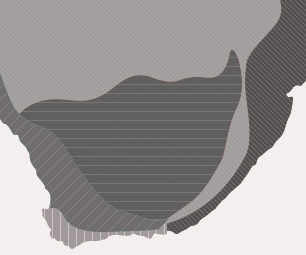








Rate this article
Article well written and informative
Rate this plant
Is this an interesting plant?
Login to add your Comment
Back to topNot registered yet? Click here to register.